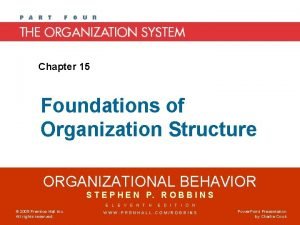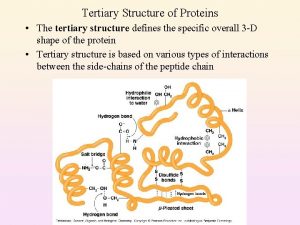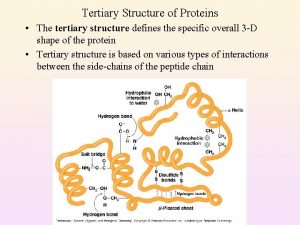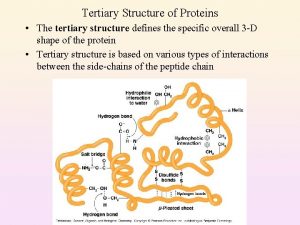Chapter 15 Foundations of Org Structure defines how










- Slides: 10

Chapter 15: Foundations of Org Structure defines how job tasks are formally divided, grouped, and coordinated. Specifically, there are six key elements that managers need to address when they design an organizational structure: 1) Work specialization - the degree to which tasks in the organization are subdivided into separate jobs. 2) Departmentalization - the basis by which jobs are grouped together. 3) Chain of command - the unbroken line of authority that extends from the top of the organization to the lowest echelon and clarifies who reports to whom.

6 Elements continued… 4) Span of control - the number of subordinates a manager can efficiently and effectively direct. 5) Centralization/Decentralization - the degree to which decision making is concentrated at a single point in the organization. Decentralization is when decision discretion is pushed down to lower-level employees. 6) Formalization - the degree to which jobs within the organization are standardized.

Key Design Questions and Answers for Designing the Proper Organization Structure

Common Designs and New Designs Common Organizational Designs Ø The Simple Structure Ø The Bureaucracy Ø The Matrix Structure New Design Options Ø The Team Structure – the use of teams as the central device to coordinate work activities. Ø The Virtual Organization – a small, core organization that out sources major business functions Ø The Boundaryless Organization – an organization that seeks to eliminate the chain of command, have limitless spans of control, and replace departments with empowered teams.

Ex) Matrix Structure

Ex) Virtual Organization

Why Do Structures Differ? Ø Strategy Innovation, cost minimization, and imitation. Ø Organization Size An organization’s size significantly affects its structure. The relationship isn’t linear, rather size affects structure at a decreasing rate. Ø Technology How an organization transfers its inputs into outputs Every organization has at least one technology for converting financial, human, and physical resources into products or services The common theme that differentiates technologies is their degree of routineness. Ø Environment Institutions or forces outside the organization that potentially affect the organization’s performance.

Mechanistic Versus Organic Models

Organizational Designs and Employee Behavior Ø It is difficult to generalize what will work best for all employees. Ø For example, work specialization may lead to higher productivity but can reduce job satisfaction. Ø Individual differences, experience, and the work task are key.

Summary and Implications for Managers Ø An organization’s internal structure contributes to explaining and predicting behavior. Ø An organization’s structure reduces ambiguity for employees. Ø The specific effect of structural designs on performance and satisfaction I moderated by employees’ individual preferences and cultural norms. Ø Managers should be reminded that structural variables like work specialization, span of control, formalization, and centralization are objective characteristics that can be measured by organizational researchers. However, most employees do not perceive structure the same way as researchers do. Instead, they observe in an “unscientific” fashion.
 Foundation of organizational structure
Foundation of organizational structure Chapter 6 lesson 1 foundations of a healthy relationship
Chapter 6 lesson 1 foundations of a healthy relationship Chapter 6 skills for healthy relationships
Chapter 6 skills for healthy relationships Chapter 2 foundations of resident care
Chapter 2 foundations of resident care Foundations of individual behavior
Foundations of individual behavior Chapter 1: foundations of government worksheet answers
Chapter 1: foundations of government worksheet answers Chapter 4 foundations background to american history
Chapter 4 foundations background to american history Chapter 1: introduction to personal finance
Chapter 1: introduction to personal finance Foundations of government vocabulary
Foundations of government vocabulary Chapter 1: foundations of government pdf
Chapter 1: foundations of government pdf Foundations of government (chapter 1 test form a)
Foundations of government (chapter 1 test form a)



















